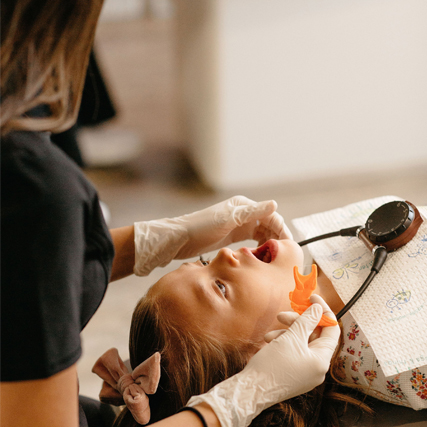Are you curious about getting some cosmetic dental work done for your child? If you think your child might be a good candidate to have some type of cosmetic dentistry treatment, then keep reading to learn more about what is available for pediatric dental patients.
What is Cosmetic Dentistry?
The words “cosmetic dentistry” sound like a serious undertaking, and in some cases that is the truth. However, the term cosmetic dentistry really applies to any dental work invasive or non-invasive that serves the purpose of enhancing or improving the appearance of your toothy smile.
Odds are good that at some point you’ve had some cosmetic dentistry performed and just didn’t realize it could be classified as such.
Is Cosmetic Dentistry Appropriate for Children?
This question requires a more nuanced answer than the previous one. Some methods of cosmetic dentistry can be appropriate for children, in certain circumstances. Let’s explore that a little more.
6 Types of Cosmetic Dental Treatments Available for Kids
1. Composite/resin fillings are a common cosmetic dental procedure for kids. They serve the important and necessary purpose of repairing a tooth that has a cavity or tooth decay, but the cosmetic part comes into play when we use our composite resin to do the job instead of the formerly more traditional amalgam. When amalgam is used, there is a visible metallic look to the tooth. Our composite resin fillings are a blend of silica and plastics which are almost clear of any color, allowing them to be tinted to match the color of the repaired tooth.
2. Porcelain crowns are the cosmetic alternative to stainless steel crowns and can be appropriate for kids. A crown is used when the tooth in question is badly damaged or decayed to the point that a filling is not sufficient. The crown is created in a lab and then when ready, placed over the tooth covering it entirely. We often recommend porcelain crowns for teeth that are readily visible, hence the cosmetic aspect. If the tooth in question that requires a crown is a baby tooth and not a permanent one, then we discuss with parents and the child factors to take into consideration, including cost and time frame for when the baby tooth can be expected to fall out.
3. Direct bonding is a cosmetic dentistry procedure that is minimally invasive and serves a purely cosmetic purpose. Discoloration, stains, chips, or gaps can be covered by using a composite resin (much like what is used for fillings). This type of cosmetic procedure may be appropriate for adolescents with permanent teeth.
4. Teeth whitening is another purely cosmetic procedure. Teenagers are as prone to be concerned with the state of their smile as an adult. Perhaps even more so because the adolescent time of life is so fraught with big body changes and confusing social dynamics. While adults often experience discoloration on their teeth due to aging, the discoloration present in the smiles of teenagers is typically a result of the assault of acids and sugars from popular and often over-consumed beverages such as sodas, juices, and energy drinks.
5. Dental flipper is a cosmetic option utilized when trauma has caused the loss of a tooth. Think of it as a partial denture, or a retainer that has a prosthetic tooth/teeth attached to it. It serves the cosmetic purpose of maintaining the appearance of a tooth and a full smile. A dental flipper is only recommended for kids when the missing tooth is a permanent one. To be clear, once a permanent tooth is lost a person can consider dental implants. However, dental implants are not recommended for anyone under the age of 18 and are an invasive dental procedure. The dental flipper is an appropriate alternative for teens in this situation.
6. No-prep veneers are also sometimes referred to as minimal prep veneers and, as the name implies, are much less invasive than their porcelain veneer counterparts. Porcelain veneers are not recommended for teens because while they likely have all their permanent teeth in, their teeth certainly haven’t finished developing. Porcelain veneers often involve grinding on the tooth’s enamel to ensure adhesion. During a permanent tooth’s development, the nerve of the tooth’s pulp is closer to the surface because the dentin layer isn’t fully formed which places it at a higher risk of nerve damage. No-prep veneers will cover the front of the tooth only and require no anesthesia for the process.
Cosmetic Dentistry Doesn’t Discount Good Dental Hygiene
The truth of the matter is that while cosmetic dentistry can give your kid a perfect white smile, only good dental hygiene can keep it that way. The costs associated with the aforementioned cosmetic dentistry options available to teens and kids may very well be prohibitive. The best thing you and your kids can do so that they have that healthy shining smile is to brush and floss twice a day, for two minutes.
If your child has had crowns or fillings it definitely means that your child has already had some experience with tooth decay which isn’t great but isn’t abnormal either. That provides you with an opportunity to connect that your family needs to focus on dental hygiene routines, and perhaps examine the consumption of snacks and beverages.
The other procedures that are purely cosmetic need to be treated with caution. It can be easy to believe that because the stains on the teeth can be covered or whitened that less diligence in dental care is required. Don’t start down that slippery slope!
If you believe that your child may need/want some cosmetic dentistry, then give us a call to come in for a checkup. You can share your concerns and interests and we can review options and factors to take into consideration. Each child’s smile is unique, as is each situation.

